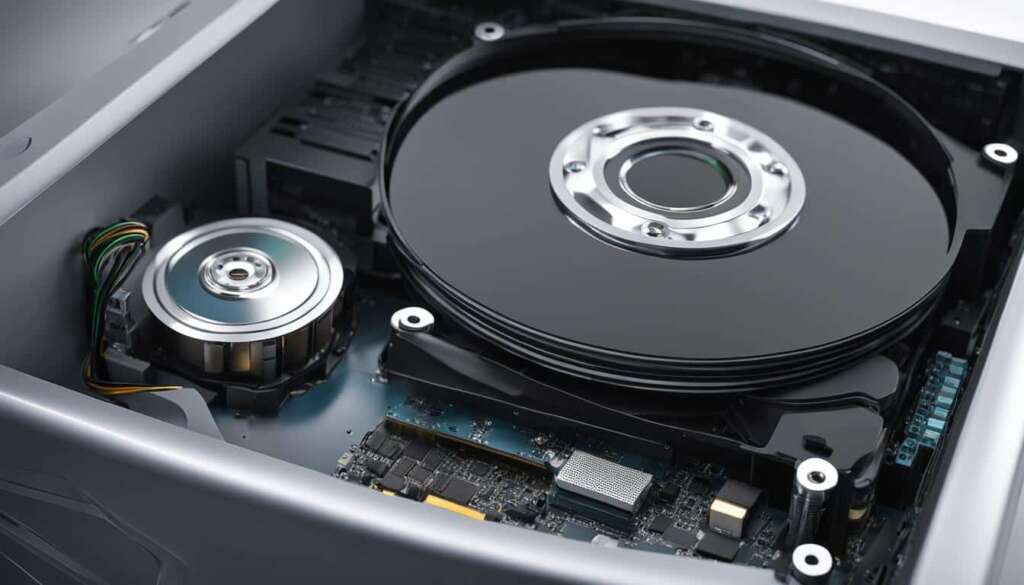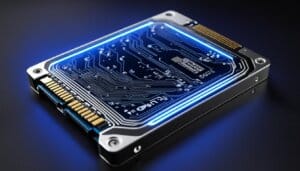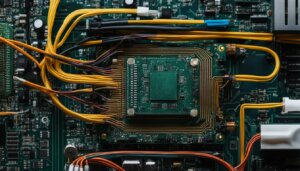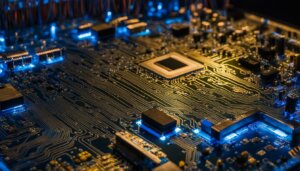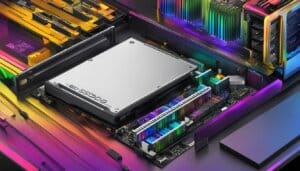Table of Contents
A hard disk drive (HDD) is a non-volatile data storage device commonly used in computers and other digital devices. It is responsible for storing and retrieving data, including operating systems, software programs, and user files. HDDs have magnetic disks known as platters, which spin at high speeds while an actuator arm reads and writes data on the platters. HDDs are essential for data storage in computers and are available in various capacities, ranging from small sizes like 16 GB to large sizes like 20 TB.
Despite the rise of solid-state drives (SSDs), HDDs continue to be widely used due to their cost-effectiveness and high storage capacity. They play a crucial role in the computing industry, offering reliable and efficient data storage solutions for businesses and individuals alike.
How Does a Hard Disk Drive Work?
A hard disk drive (HDD) operates by utilizing spinning platters and an actuator arm to read and write data. The key components of an HDD include magnetic disks known as platters, a motor, and an actuator arm with read and write heads.
The platters are circular disks made of durable materials such as aluminum, glass, or ceramic. They have a magnetic coating that stores data in tracks and sectors. When the HDD is in operation, a motor spins the platters at high speeds, commonly reaching up to 15,000 rotations per minute.
The actuator arm, positioned above the platters, is equipped with read and write heads. These heads magnetically record and retrieve data from specific locations on the platters. The actuator arm swiftly moves across the platters to access the required data, allowing the HDD to retrieve or store information as needed.
This seamless process of spinning platters and the movement of the actuator arm enables the hard disk drive to efficiently read and write data, making it an integral component in computer systems and data storage solutions.
| Component | Function |
|---|---|
| Platters | Circular disks that store data with a magnetic coating. |
| Motor | Spins the platters at high speeds, up to 15,000 rotations per minute. |
| Actuator Arm | Moves across the platters, containing read and write heads to access and manipulate data. |
Hard Drive Components and Form Factors
A hard disk drive (HDD) is composed of several key components that work together to store and retrieve data. Understanding these components is essential for gaining insight into how an HDD functions and its form factors.
Hard Drive Components
The main components of a hard disk drive include:
- The spindle: The spindle is the central axis that holds the disk platters and allows them to spin. It ensures the smooth rotation of the platters, which is crucial for the read and write processes.
- The disk platter: The disk platters are the magnetic disks on which data is stored. They are made of durable materials like aluminum, glass, or ceramic and are coated with a magnetic layer that allows the read/write heads to record and retrieve data.
- The actuator arm: The actuator arm is responsible for moving the read/write heads across the disk platters. It positions the read/write heads precisely to access specific areas of the platters, allowing the retrieval or recording of data.
- The read/write head: The read/write heads are the magnetic heads that read and write data on the disk platters. They hover just above the platters and use magnetic fields to record and detect data. The read/write heads are crucial for the accuracy and speed of data retrieval and recording.
These components work together seamlessly within the HDD, enabling the storage and retrieval of data during normal operation.
Hard Drive Form Factors
In addition to the components, hard disk drives come in different form factors. The form factor refers to the physical size and compatibility of the HDD with various computing devices. The most common form factors for HDDs are the 2.5-inch and 3.5-inch sizes.
| Form Factor | Description | Common Usage |
|---|---|---|
| 2.5-inch | Smaller size | Laptops, portable devices |
| 3.5-inch | Larger size | Desktop computers, workstations |
These form factors determine the compatibility of the HDD with different devices. It’s important to choose the right form factor when considering storage upgrades or replacements.
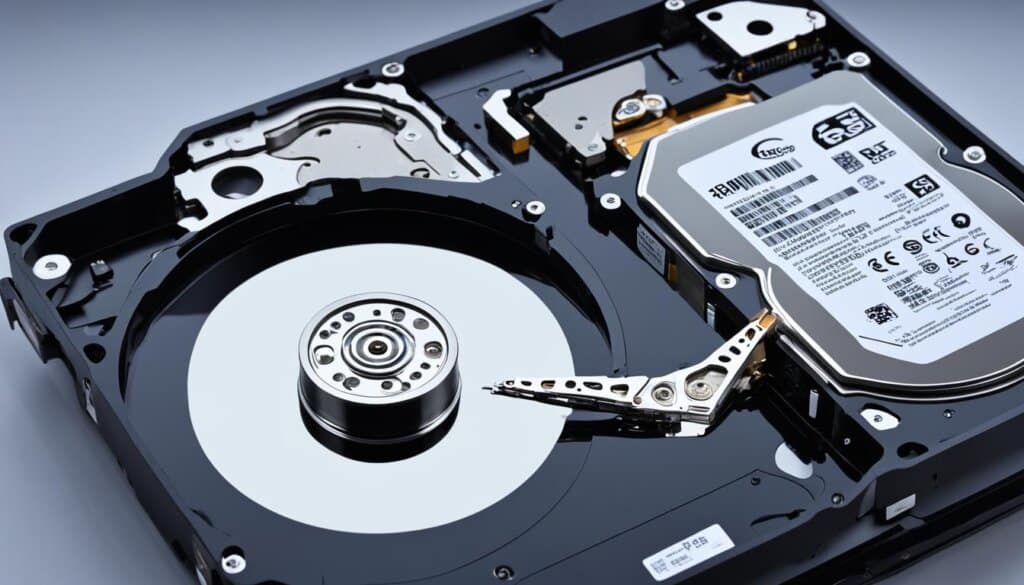
The image above visually represents the components and form factors of a hard disk drive.
Advantages and Disadvantages of HDDs
HDDs, or hard disk drives, offer several advantages in terms of data storage. One of the key advantages is their large storage capacities. HDDs can hold vast amounts of data, making them suitable for storing a wide range of files, including programs, documents, and multimedia content. They provide the necessary space for businesses and individuals with high storage requirements.
In addition to their storage capacity, HDDs are also known for being cost-effective. Compared to other storage solutions, such as solid-state drives (SSDs), HDDs are generally more affordable. This makes them an attractive choice for those on a tighter budget or looking for a cost-effective storage solution without compromising on capacity.
However, it is important to consider the disadvantages of HDDs as well. One significant drawback is their slower speeds when it comes to data retrieval, especially with larger files. This slower speed can impact overall system performance, especially in tasks that require quick access to data.
Another disadvantage of HDDs is their mechanical components, which make them more susceptible to failures. This includes both electrical and mechanical failures. As HDDs rely on moving parts, such as the spinning disks and actuator arm, there is a higher chance of mechanical failure occurring over time. These failures can lead to data loss or system malfunctions, requiring repair or replacement.
Despite their disadvantages, HDDs remain a popular choice for many due to their affordability and high storage capacity. It is important for users to weigh the advantages and disadvantages based on their specific needs and budget before making a decision on the type of storage solution to use.
FAQ
What is a hard disk drive (HDD)?
A hard disk drive (HDD) is a non-volatile data storage device commonly used in computers and other digital devices to store and retrieve data.
How does a hard disk drive work?
A hard disk drive uses spinning platters and an actuator arm to read and write data. The platters are circular disks that store data using a magnetic coating, while the actuator arm moves across the platters to access specific data locations.
What are the main components of a hard disk drive?
The main components of a hard disk drive include the spindle, disk platter, actuator arm, and read/write head. The spindle holds the disk platters and allows them to spin, while the actuator arm moves the read/write heads across the platters to access data.
What are the different form factors of hard disk drives?
Hard disk drives come in different form factors, such as 2.5-inch and 3.5-inch, which determine their physical size and compatibility with different computing devices.
What are the advantages of HDDs?
HDDs offer large storage capacities and cost-effectiveness compared to other storage solutions. They are suitable for storing a wide range of data, including programs, files, and media.
What are the disadvantages of HDDs?
HDDs are slower in terms of data retrieval, especially with larger files, and are more prone to mechanical failures compared to other storage options.


